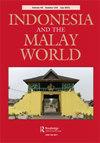IF 0.9
3区 社会学
0 ASIAN STUDIES
引用次数: 3
摘要
摘要伊斯兰教在印度尼西亚东部的兴起,通常被认为是15世纪末以后穆斯林商人的活动。这种假设过于简化,特别是在主要贸易中心以外的地区。在阿鲁群岛,伊斯兰教于17世纪中期传入。我们认为,阿鲁的伊斯兰化最初是出于内部考虑,而不是贸易问题。我们从两个地方介绍了伊斯兰教扩张的口头传统:乌吉尔,西海岸阿鲁的历史穆斯林中心,和本朱岭,东部当地祖先信仰的前据点。口头资料来源与17世纪欧洲对穆斯林和新教中心首次在阿鲁发展的描述并列。伊斯兰教的到来迫使人们要么皈依伊斯兰教,要么前往非穆斯林地区。到殖民时代晚期(20世纪初),伊斯兰教和新教都已到达偏远的村庄。阿鲁最近一次皈依国家认可的世界宗教的浪潮发生在20世纪70年代。在过去的30年里,阿鲁的人口不断增长,尤其是在摄政首都多博。虽然穆斯林曾经是阿鲁的少数民族,他们的主要中心在乌吉尔岛,但重心已经转移到了多博,这是一个快速发展的城镇,大量穆斯林从印度尼西亚其他地区涌入。阿鲁的伊斯兰化仍在继续,伊斯兰教的性质正在发生变化。本文章由计算机程序翻译,如有差异,请以英文原文为准。
Islam in Aru, Indonesia
ABSTRACT The coming of Islam in eastern Indonesia is generally assigned to the activities of Muslim traders from the late 15th century onwards. This assumption is an over-simplification, especially in areas outside the main trade centres. In the Aru islands, Islam was introduced by the mid 17th century. We argue that Islamisation in Aru was initially a matter of internal considerations, rather than trade. We present oral traditions about the expansion of Islam as seen from two locations: Ujir, the historical Muslim centre in Aru on the west coast, and Benjuring, a former stronghold of local ancestral beliefs in the east. The oral sources are juxtaposed with European accounts of the 17th century when Muslim and Protestant centres first developed in Aru. The coming of Islam forced people to either convert or leave for non-Muslim areas. By late colonial times (early 20th century), both Islam and the Protestant church had reached remote villages. The most recent wave of conversions in Aru to state-approved world religions took place in the 1970s. In the last 30 years, the population in Aru has grown, especially in the regency capital Dobo. While Muslims used to be a small minority in Aru with their main centre on Ujir island, the point of gravity has shifted to Dobo, a fast-growing town with a large influx of mostly Muslims from other parts of Indonesia. Islamisation is still ongoing in Aru and the character of Islam is changing.
求助全文
通过发布文献求助,成功后即可免费获取论文全文。
去求助
来源期刊

Indonesia and the Malay World
ASIAN STUDIES-
CiteScore
2.00
自引率
0.00%
发文量
17
期刊介绍:
Indonesia and the Malay World is a peer-reviewed journal that is committed to the publication of scholarship in the arts and humanities on maritime Southeast Asia. It particularly focuses on the study of the languages, literatures, art, archaeology, history, religion, anthropology, performing arts, cinema and tourism of the region. In addition to welcoming individual articles, it also publishes special issues focusing on a particular theme or region. The journal is published three times a year, in March, July, and November.
 求助内容:
求助内容: 应助结果提醒方式:
应助结果提醒方式:


